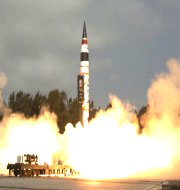Agni-5 ballistic missile successfully test-fired
Indigenously developed long-range surface-to-surface Agni-5 ballistic missile was successfully test fired successfully from Abdul Kalam Wheeler Island, Odisha.
It was overall fifth developmental trial test of the long-range missile carried out by Strategic Forces Command of Indian Army to check its operational readiness. The last test of missile was conducted in December 2016 from same test range.
Agni-5 ballistic missile
The Agni-5 is three-stage solid propellant nuclear-capable intercontinental ballistic missile (ICBM), indigenously developed by the Defence Research and Development Organisation (DRDO).
It is about 17 metres long, 2 metres wide and has a launch weight of around 50 tonnes. It has strike range of over 5,000 kilometres and can carry nuclear warhead of more than one tonne. Thus, it can hit most northern parts of China and other parts of Asia, Europe and Africa. It has not yet inducted into the Services.
Unlike other missiles of Agni series, Agni-5 is most advanced missile having new technologies incorporated with it in terms of navigation and guidance, warhead and engine. It is also a fire and forget missile, which once fired cannot be stopped, except by interceptor missile which only US, Russia and Israel have.
It carries Multiple Independently Targetable Re-entry Vehicles (MIRV) payloads. A single MIRV equipped missile that can deliver multiple warheads at different targets. It is also incorporates advanced technologies involving ring laser gyroscope and accelerometer for navigation and guidance.
Comment
After some few more trials, it will be inducted into arsenal of tri-Service Strategic Forces Command which manages India’s nuclear arsenal. Once this missile is inducted into Services, India will join super exclusive club of countries with ICMBs (range of over 5,000-5,500 km) alongside US, Russia, China, France and United Kingdom.
India at present in its armoury of Agni series has Agni-1 (700 km range), Agni-2 (2000 km range,) Agni-3 and Agni-4 (2500 km to more than 3500km range).

Month: Current Affairs - January, 2018


